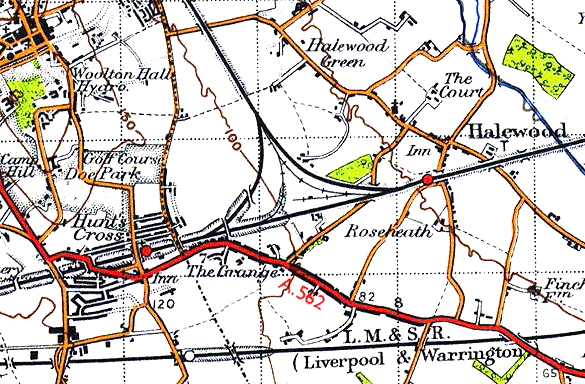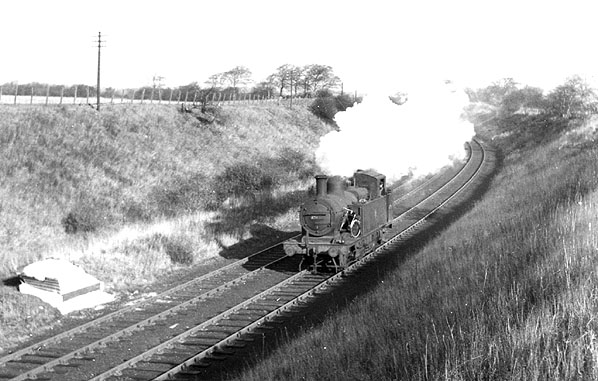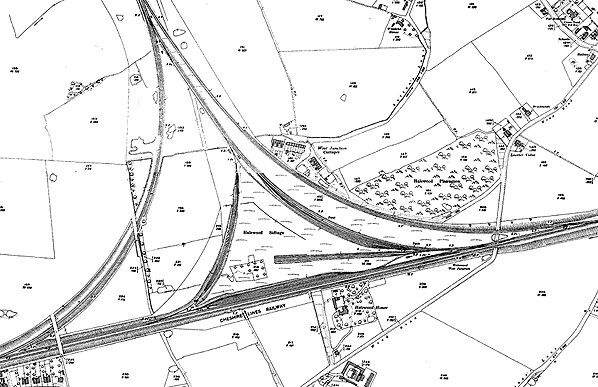 |
The Halewood triangle, located to the west of Halewood village, was part of the Cheshire Lines Committee Railway (CLC) system. The CLC was a joint railway formed on 5 July 1865 by the Great Northern Railway (GNR) and the Manchester Sheffield & Lincolnshire Railway (MS&LR). On 18 July 1866 the Midland Railway (MR) also became a partner. The CLC partners were dissatisfied with arrangements they had for reaching Liverpool via the Warrington & Stockport and the Garston & Warrington lines which had become part of the London & North Western Railway (LNWR) by 1864. The LNWR did all that it could to make things difficult for the CLC. It was for that reason that they promoted a direct line of their own between Cressington Junction (Garston) and Throstle Nest Junction (Trafford) which was granted an Act on 6 July 1865. At Cressington the line connected with the Garston and Liverpool Railway which had already become CLC and at Throstle Nest with the CLC mid Cheshire line that provided access to Manchester. A CLC through route between the two cities was thereby created which opened on 2 September 1873. The 1865 Act also made provision for a spur from Glazebrook to Skelton Junction which linked with another CLC line and gave the MR direct access to Liverpool avoiding Manchester. It opened with the section of line from Glazebrook to Cressington Junction a month earlier than the main line on 1 August 1873. A station opened at Halewood in May 1874.
The CLC line was a double-track railway, the Liverpool direction line being the ‘Down’ and the Manchester direction the ‘Up’.
With the opening of the main line the CLC partners had their access to Liverpool but by the 1870s new docks, capable of accommodating larger ships, were being created on the north side of the city; the CLC wanted access to these docks. Although the docks were only a few miles to the north of Liverpool Central, to build a line directly to them would involve expensive tunnelling under the city centre. A cheaper alternative was to build a line to the east of the city from Halewood via Gateacre, Knotty Ash, West Derby and Walton to Aintree. From Walton a branch would run down to the north docks at Huskisson. The line was authorised on 30 July 1874 as the North Liverpool Extension Line.
The North Liverpool Extension Line connected to the main line west of Halewood station. It had two connections an east-facing junction (Halewood East Junction) 6 chains to the west of the station and a west-facing junction (Hunts Cross East Junction) 1 mile and 9 chains to the west. The lines from each of the junctions converged at Halewood North Junction which was 75 chains from Halewood station via the east-facing junction. A triangle was therefore created at Halewood and sidings were constructed within it to facilitate the operation of goods trains.
The North Liverpool Extension Line opened between Hunts Cross East Junction and Walton-on-the-Hill on 1 December 1879. On 1 July the line to Huskisson opened, and goods services began to operate on the North Liverpool Extension Line.
The North Liverpool Extension Line was also a double-track railway. Aintree/Huskisson was the ‘Down’ direction and Halewood the ‘Up’. The Halewood Junction – Halewood North Junction spur of the triangle also followed this protocol with Aintree/Huskisson being Down and Halewood Up. The Hunts Cross East Junction to Halewood North Junction spur was more complex with the Aintree/Huskisson direction line being the ‘Up’ as far as Halewood North Junction (after which it became the ‘down’) and the Hunts Cross direction line being the Down from Halewood North Junction onwards to Liverpool.
Halewood East Junction was the eastern point of the triangle. It was controlled by a signal box located on the south side of the line. It also controlled access at the eastern end to sidings that ran parallel with the main line on the north side, and it was the point at which the North Liverpool Extension Line east-to-north spur diverged from the main line.
Halewood North Junction was controlled by a signal box on the east side of the line. Beyond the junction a footpath passed under the line in a short tunnel. On the east side of the triangle a row of cottages was built for railway employees.
The sidings at Halewood were used for marshalling trains, and locomotives were provided by Walton-on-the-Hill shed.
In 1883 the line between Halewood East and Hunts Cross West Junction became quadruple. The point at which the double-track line became quadruple was six chains west of Halewood station. The new lines were designated as the Up and the Down slow lines.
On 1 September 1884 the Southport & Cheshire Lines Extension Railway (S&CLER) opened between Aintree and Southport Lord Street. Passenger and freight trains began to run between Southport and Manchester over the east curve of the triangle and also over the west curve between Liverpool and Southport.
In 1897 a new line for passenger trains and fast freight services was opened from Halewood East Junction to Halewood North Junction. It ran parallel to the original route but slightly east of it. At the same time a line was put in from the original east spur which curved to the west joining the main line just to the east of Hunts Cross East Junction. This line created a triangle within a triangle, with the inner triangle being used exclusively for freight trains. A new signal box on the west side of the line was opened at Halewood North Junction on 4 June 1897; additional sidings were also laid. The original Halewood East junction was designated as Halewood West Junction and provided with a signal box on the south side of the line.
The Halewood triangle had become a significant railway location on the CLC system. Passenger and through goods trains passed along all sides of the outer triangle whilst local goods services used the inner triangle and the sidings. Goods trains were also marshalled at Halewood for onward movement onto or off the North Liverpool Extension Line.
During the Second World War the North Liverpool Extension Line, having a connection to the Liverpool docks, was extremely busy. Additional sidings were laid out at Halewood to accommodate the extra traffic.
Halewood station closed on 17 September 1951, and passenger trains between Aintree Central and Southport Lord Street were withdrawn on 7 July 1952. The Halewood triangle remained a busy location in the 1950s. On 21 October 1962 a new British Railways signal box opened in the fork between the main line and the eastern spur to control both Halewood East and West junctions and permit the controlling boxes for those junctions to close.
On 7 November 1960 passenger services between Aintree Central and Manchester Central ceased. This left the eastern spur of the triangle without regular passenger trains, although Grand National specials to and from Aintree continued to use it as did excursion trains to Southport Chapel Street.
The period after 1965 saw a massive decline in the fortunes of the Halewood triangle. On 14 May 1967 the quadruple lines between Hunts Cross East and Halewood East Junction became double-track with the closure of the Up and Down slow lines. On the same day the inner triangle and all of the sidings were taken out of use. The 1897 line between Halewood East Junction and Halewood North Junction closed on 28 October 1968, regular traffic over it having ceased on 5 August 1968. Halewood North Junction signal box closed on 27 October 1968. In the same year the line between Fazakerley South Junction and Aintree closed; this left only the main line and the western spur of the triangle. The western spur was used only by an hourly passenger service between Gateacre and Liverpool Central and by freight trains between Edge Hill and Huskisson.
The last Gateacre passenger trains ran on 15 April 1972. On 26 September 1973 the line between Gateacre and Hunts Cross was singled - having been singled between Gateacre and Knotty Ash on 21 October 1972 and between Knotty Ash and Walton-on-the-Hill on 30 November 1969). The last freight trains ran to Huskisson in July 1975. The single-track line along the western spur of the Halewood triangle was taken up in the early months of 1979. Other than the main line which remained open, the Halewood triangle was no more.
Halewood East signal box remained open until it was destroyed by fire on 26 October 1981. On the 16 May 1988 a new Halewood station opened on the site of the Halewood East Junction. In the late 1980s a housing estate was built on most of the area of the inner triangle and the western end of the sidings.
The rest of the Halewood triangle had been recognised by a Merseyside County Council report as having significant value for nature conservation, and it was suggested that it be laid out as a Country Park. Knowsley Borough Council developed this facility between 1982 and 1986. On 21 June 1996 a park visitor centre officially opened on the trackbed of the eastern spur.
In 2012 there was much of railway interest still to be seen within the Country Park.
The 8D Association - Dedicated to promoting the history of South Lancashire and North Cheshire railways. Web Site
|



.jpg)

.jpg)
.jpg)

 Home Page
Home Page